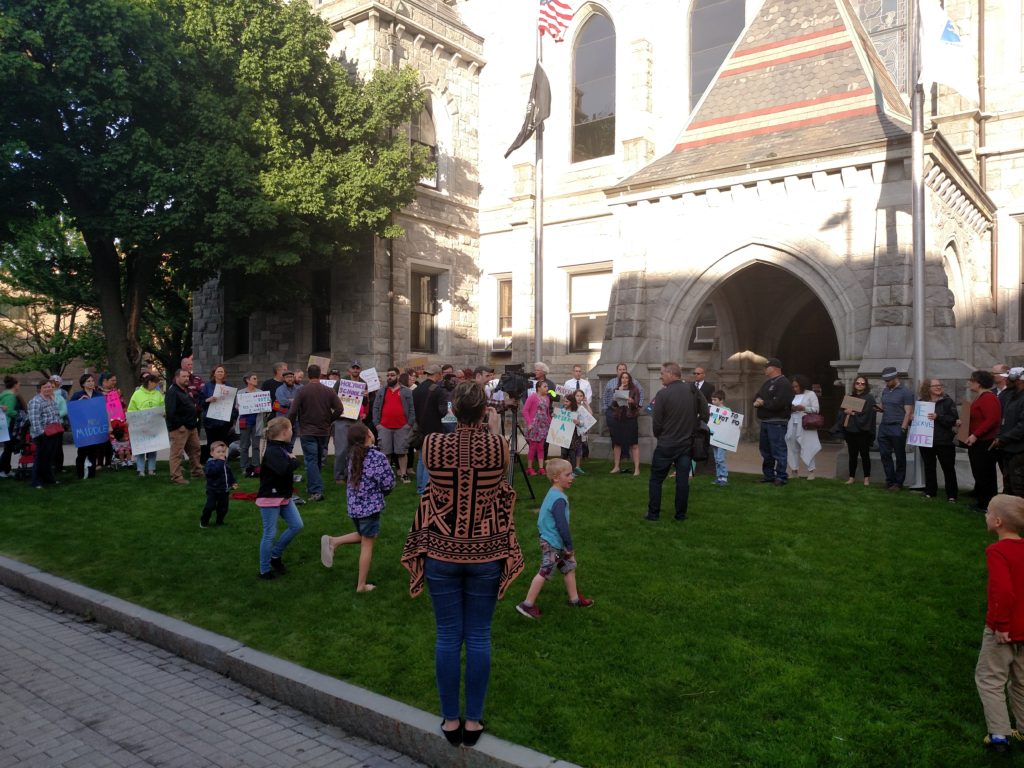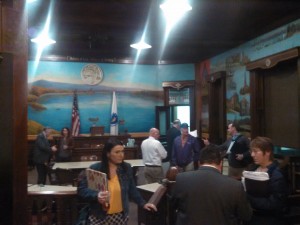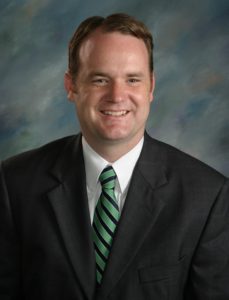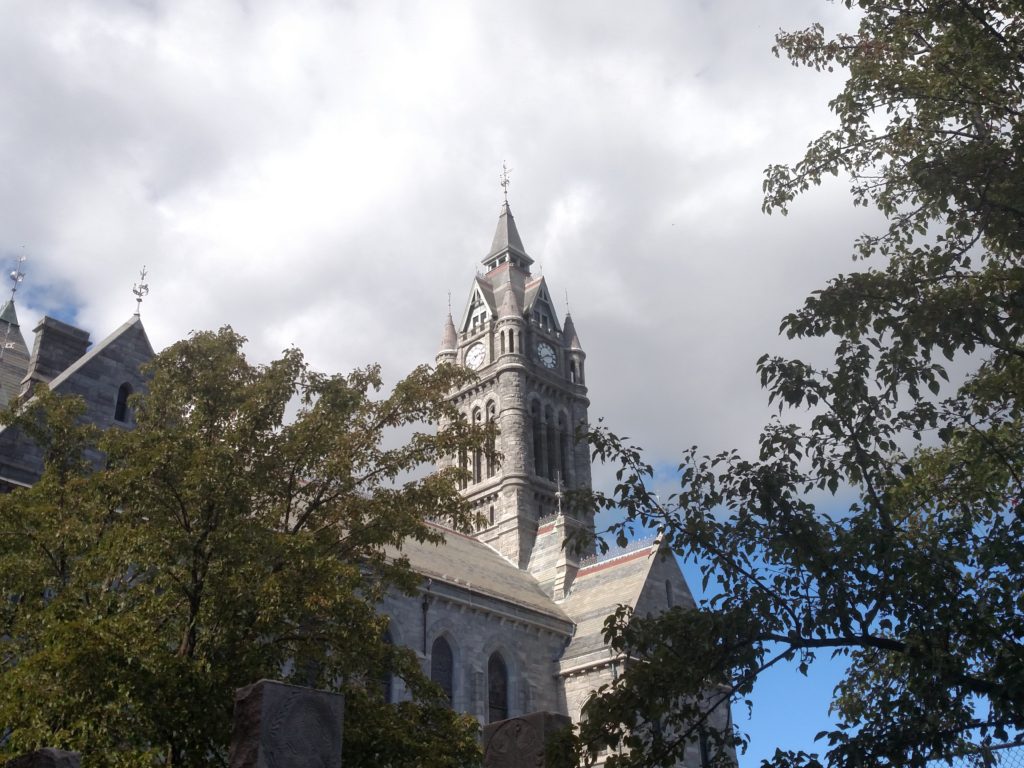Analysis: With School Funding Debate, Holyoke Reckons with Much More…
UPDATED 9:37PM: On Tuesday night, the Holyoke City Council voted to advance the two-school debt exclusion question to voters on November 5.
HOLYOKE—Not quite two weeks ago, supporters of a debt exclusion ballot question rallied on the High Street lawn outside City Hall here. Buffeting the speakers, supporters, politicians, educators and, of course, public school students, was a strong wind. It roared down the grid of the city adding a brisk note to the civic display unfolding. It was, however, not the only crosscurrent shaping efforts to borrow millions of dollars to build two new middle schools.
There are perfectly valid arguments against the question. Such reason has not always permeated Holyoke debates, however. This is no exception. Perhaps Holyoke cannot bear to turn to its tax base for this project. But the opposition to even asking its residents that question reflects a distrust of citizens and has, at times, devolved to dissonance between the governed and governors.
Holyoke presents a unique challenge to address chronic social needs. Unlike Springfield, also a socioeconomically disadvantaged city, the Paper City lacks the budget space to carry large bond loads. While the city’s taxpayers won’t pay the entire $132 million project cost, the remaining $55 million or so couldn’t fit in without cuts to services and personnel.
But Springfield only got there through the fires of near-bankruptcy, a fate Holyoke has heretofore avoided. Hence, the middle school project supporters have turned to a debt exclusion. If passed, it would add the bond payments to the city’s overall tax levy, distributing them as it divides existing property taxes among residents and businesses.
The Massachusetts School Building Authority (MSBA) will pick up around 80% of eligible costs—ultimately about 60% of total cost—but the city finance the rest. Tax increase talk, unsurprisingly, has engendered pushback. Some have balked or tried to slash the cost or conjure better reimbursement from the state.
Holyoke’s City Council will consider scheduling the bond on Tuesday. It would only set the date for voters to weigh in. Without a public endorsement, the project would likely die.
At the rally on May 21, supporters emphasized how long educational infrastructure needs had gone without redress.
One speaker, who was a reporter in the 1990’s, recalled the poor quality of many school buildings even then. Now there are “rooms in such disrepair, they were deemed a threat to life and property.”
Rebecca Lisi, an at-large councilor who has led the charge on the issue, urged attendees to in turn urge councilors to just give the people a voice on the subject. Holyoke, she continued, could not hold out hope for some other means or entity to correct the problem.
“We can no longer wait for other to do the work of remaking and rebuilding out city,” she said.
The pressure continued inside as many of the rallygoers urged the Council to simply put the question to voters.
As Holyoke has changed, direct action has become more popular. While some councilors are unmoved, it can be very powerful when the appeal is for the city’s children. A simple “We can’t afford it!” may not be politically palatable when the voters, not elected officials, would have the final say.
Consequently, some councilors have tried to find alternative solutions. Council President Todd McGee argued that Treasurer Deb Goldberg needed to intervene with the MSBA, which she chairs, to get Holyoke its full 80% reimbursement. Yet, Hoyloke already gets that. The 60% reimbursement figure bandied about reflects the actual reimbursement rate all “80% communities” get after ineligible costs, like land acquisition, are stripped out.
McGee did not return a request for comment.
Ward 2 Councilor Terrence Murphy sought to scale back the project to a one-school project. But the MSBA informed the Council that it had approved a two-school design and replacing only one school was not an option. Holyoke would have to go to the end of the line if it wanted to propose a new project.
To their credit, after meeting with the MSBA’s executive director, both McGee and Murphy voted in committee last week to advance the ballot question to the full Council.
But on social media, opponents still raise suggestions those councilors abandoned. Other posters point to pending legislation that would give Holyoke more money. These almost certainly won’t pass soon.
Many such people mean well, but the project has already been in the works for years. The roots of the middle school replacement predate Holyoke schools’ receivership in 2015. However, that event led to a broader review of the city’s stock of education facilities. An MSBA-financed study zeroed in on the middle schools. As it happens, those intermediate grades are also when troubles urban schoolchildren experience are seeded.
The cost is daunting. Were the bond approved, the city would bond the entire $132 million. The MSBA disperses funds as costs come in for a project. The added levy on taxpayers would make up the rest.
However, the true cost to taxpayers is not known. One analysis puts the worst-case scenario as an additional $240 annually for a $200,000 home in Holyoke. As commercial tax rates are higher, a similar valued business property would pay more. Better figures would become available after the Council sets the date to hold the debt exclusion vote.
At that point, the exact cost of the project can be pinpointed (final design can occur once the question is scheduled), outside monies secured, and the final terms of the bond set. All should happen before the public vote is held. As an additional safety measure, the Council must vote to appropriate the bond. In other words, hypothetically, councilors have another chance to squelch the bond if the terms are too unfavorable.
Opponents are understandably arguing the cost to businesses and many homeowners is too much to bear. But some as to insist the bond, which needs nine councilors’ votes to go to the ballot, should not even advance.
If the Council were final say, a pressure campaign on city lawmakers would be appropriate. But they are not the final arbiters. Voters are.
While not universally true among debt exclusion pearl-clutchers, the reluctance betrays a lack of faith in voters. Certainly, as independent media has withered away, fewer broad means to inform the public exist. But an issue like this—schoolchildren vs. taxes—would have touched the same emotional chords in an era of robust local press.
It may well be that Holyoke cannot risk raising more revenue from its wan tax base. But it cannot just be a gut reaction of taxation is bad and businesses will automatically flee. The explanation must be reasoned and backed with data.
Likewise, supporters of the bond have a burden. They are up to the challenge. Backers have already readied arguments that two new schools will attract investment in the city via new homeowners or will save the city on transportation and staffing.
Much of the savings will probably end up going back to the schools because the state finances most educational expenses in the city. (The commonwealth pays more than 80% of Holyoke annual school budget). However, some of it may redound to the non-school side of the city ledger.
Erin Brunelle, an at-large school committee member, pleaded with councilors after the rally to let voters decide on this investment. Clutching her own kids, she pointed to programs in the school that must limit enrollment due to popularity, countering the resign often seen with inner city school district.
“That alone shows you we are developing programs that are in demand,” she said.
Ironically, such emotion actually demands a bigger public debate on the issue. Opponents, whether business owners or residents should relish the chance to make their case. Neither side should assume the outcome. Holyoke has rejected similar questions before.
Until Beacon Hill wakes up to the chaos its neglect and inertia have caused, the consequences will face reckonings on the local level. The argument will be good for Holyoke as it has been for other communities like Easthampton and Ludlow that have had similar debt exclusions. Perhaps only if more questions succeed—or fail—a fire will ignite under the legislature to find more equitable solutions, especially for communities of limited means.



